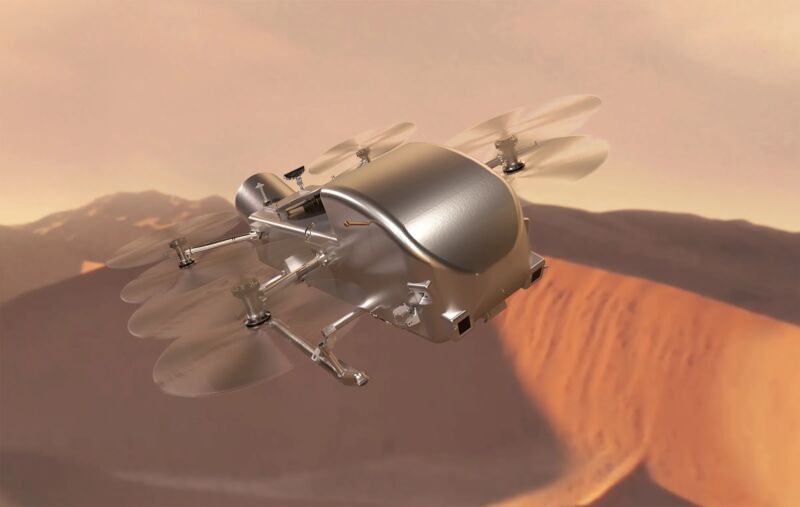
NASA has formally approved the robotic Dragonfly mission for full development, committing to a revolutionary project to explore Saturn’s largest moon with a quadcopter drone.
Agency officials announced the outcome of Dragonfly’s confirmation review last week. This review is a checkpoint in the lifetime of most NASA projects and marks the moment when the agency formally commits to the final design, construction, and launch of a space mission. The outcome of each mission’s confirmation review typically establishes a budgetary and schedule commitment.
“Dragonfly is a spectacular science mission with broad community interest, and we are excited to take the next steps on this mission,” said Nicky Fox, associate administrator of NASA’s science mission directorate. “Exploring Titan will push the boundaries of what we can do with rotorcraft outside of Earth.”
In the case of Dragonfly, NASA confirmed the mission with a total lifecycle cost of $3.35 billion and a launch date of July 2028. That is roughly twice the mission’s original proposed cost and a delay of more than two years from when the mission was originally selected in 2019, according to NASA.
Busting the cost cap
Rising costs are not necessarily a surprise on a mission as innovative as Dragonfly. After reaching Titan, the eight-bladed rotorcraft lander will soar from place to place on Saturn’s hazy moon, exploring environments rich in organic molecules, the building blocks of life.
Dragonfly will be the first mobile robot explorer to land on any other planetary body besides the Moon and Mars, and only the second flying drone to explore another planet. NASA’s Ingenuity helicopter on Mars was the first. Dragonfly will be more than 200 times as massive as Ingenuity and will operate six times farther from Earth.
Despite its distant position in the cold outer Solar System, Titan appears to be reminiscent of the ancient Earth. A shroud of orange haze envelops Saturn’s largest moon, and Titan’s surface is covered with sand dunes and methane lakes.
Titan’s frigid temperatures—hovering near minus 290° Fahrenheit (minus 179° Celsius)—mean water ice behaves like bedrock. NASA’s Cassini spacecraft, which flew past Titan numerous times before its mission ended in 2017, discovered weather systems on the hazy moon. Observations from Cassini found evidence for hydrocarbon rains and winds that appear to generate waves in Titan’s methane lakes.
Clearly, Titan is an exotic world. Most of what scientists know about Titan comes from measurements collected by Cassini and the European Space Agency’s Huygens probe, which Cassini released to land on Titan in 2005. Huygens returned the first pictures from Titan’s surface, but it only transmitted data for 72 minutes.
Dragonfly will explore Titan for around three years, flying tens of kilometers about once per month to measure the prebiotic chemistry of Titan’s surface, study its soupy atmosphere, and search for biosignatures that could be indications of life. The mission will visit more than 30 locations within Titan’s equatorial region, according to a presentation by Elizabeth Turtle, Dragonfly’s principal investigator at the Johns Hopkins University Applied Physics Laboratory.
“The Dragonfly mission is an incredible opportunity to explore an ocean world in a way that we have never done before,” Turtle said in a statement. “The team is dedicated and enthusiastic about accomplishing this unprecedented investigation of the complex carbon chemistry that exists on the surface of Titan and the innovative technology bringing this first-of-its-kind space mission to life.”
However, this high level of ambition comes at a high cost. NASA selected Dragonfly to proceed into initial development in 2019. Turtle’s science team proposed Dragonfly to NASA through the agency’s New Frontiers program, which has developed a series of medium-class Solar System exploration missions. The New Frontiers program has an impressive pedigree, beginning with the New Horizons mission that flew by Pluto in 2015, the Juno mission to Jupiter, and the OSIRIS-REx asteroid sample return mission.
